And he’s off, streaking across the screen in the film’s first true “how’d they do that” moment. Vastly underestimated teenage space monster Clark Kent isn’t allowed to kick footballs or attend age-appropriate social gatherings, so he’s expressing his frustration in a typically reckless way: using his super-speed to race with the Kansas Star, an occupied passenger train full of curious little girls with binoculars.
He hasn’t developed any catchphrases yet, so he doesn’t realize that it’s not supposed to be “faster than a locomotive” — it’s faster than a speeding bullet, more powerful than a locomotive. The dumb kid’s got it all mixed up.

Modern audiences, who are used to everything being done by greenscreen, may not appreciate how clever this entirely practical effect actually is. That really is Jeff East out in the sunshine, running faster than a train.
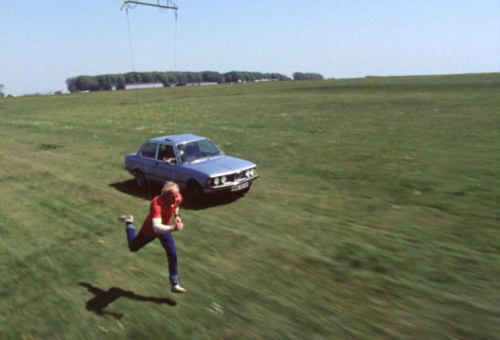
They accomplished this by putting him on a harness suspended from a crane, so that his feet don’t quite touch the ground.
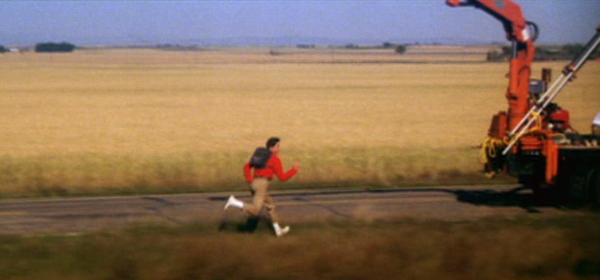
The camera is tracking alongside the boy as he speeds along, keeping the crane out of the frame while he pretends to run, suspended just above ground level. It’s a lovely shot.

They actually swung him in front of an oncoming train, too, for the moment when he turns and jumps the track. I don’t always get this excited over the making-of details, but I think this one is clever and effective and I wanted to tell you all about it.

Now that’s out of my system, let’s turn to the other element in the scene: the little girl who spots Clark running and tries to attract the attention of her parents, who don’t see him, as per the standard ironic nobody-believes-children-who-spot-the-supernatural trope.
The parents themselves are a bit of a clever effect, because this is the first superhero movie Easter egg: they’re Kirk Alyn and Noel Neill, who played Superman and Lois Lane in the 1948 chapter serial Superman, the first adaptation of this story to reach the silver screen.
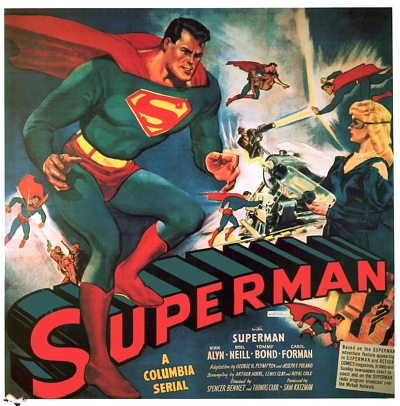
So we might as well take this opportunity to take a glance at how they handled the introduction to the material, the first time around. As we’ve discussed before, after Superman’s debut in Action Comics, the character quickly jumped to a comic strip and a radio show, but he was a bit slow making his way to the Saturday afternoon matinees. Fellow comic-strip heroes Flash Gordon, Buck Rogers and Dick Tracy all had their own serials in the late 30s and early 40s, Fawcett Comics’ knockoff Captain Marvel had a serial in 1941, and Superman’s buddy Batman made it to the screen in 1943, but Superman took the long way around and only showed up once the serial format was on the wane as a force in American entertainment.
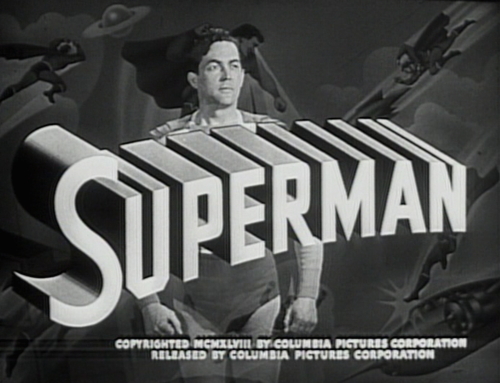
He finally made it to the screen in Columbia Pictures’ 1948 serial, a 15-week storyline in which Superman squared off against the glamorous and ruthless Spider Lady, a camp science criminal who holds Metropolis for ransom with the threat of her powerful reducer ray.
Superman was played by Kirk Alyn, a song-and-dance man from 1930s Broadway and vaudeville who moved to Los Angeles to try and break into movies, which he mostly didn’t do until Superman came along. He had a dancer’s muscular physique, and played Superman on the balls of his feet, always in the process of leaping in and out of the frame.

Of course, if you’re going to do a version of Superman then you need to go through the whole origin story first, with Jor-El and Lara and the whole “Krypton is doomed” scenario.

The science council scene at the start of chapter one is four minutes long, and feels like an eternity, going through the evidence for and against Jor-El’s theory, several times over. Maybe it’s just because I’ve spent the last several weeks looking at multiple iterations of the science council sequence, but it seems to me like they went to all the trouble of making costumes out of the living room curtains and just wanted to make sure they got their money’s worth.
At the end of the sequence, Krypton blows up, as it always has and always will, depicted by shots of models of an exploding volcano and the Hoover Dam burst open by floodwaters.
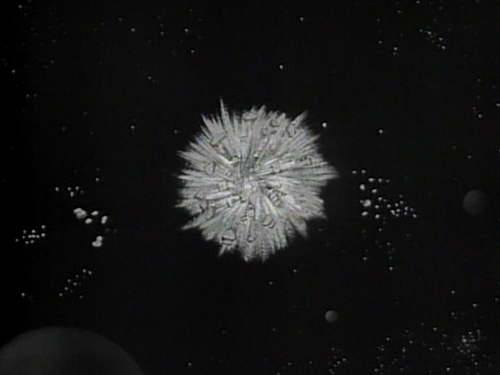
All of the complex effects in the serial like careening rockets and exploding planets are handled with animation, so every once in a while things turn into cartoons, and stay that way until events settle down.
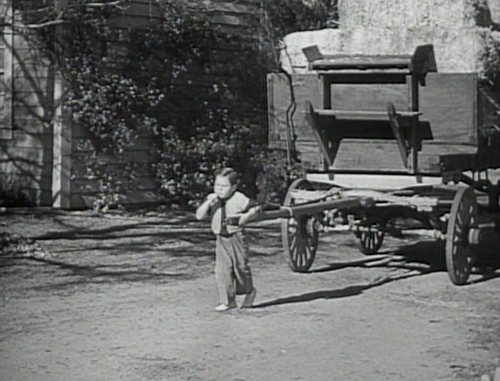
They do the Kents-as-passing-motorists scenario, and then we see young Clark, apparently put to work on the farm as a toddler, which is an aspect that the other versions we’ve looked at haven’t thought to address. This shot makes me wonder if the Kents weren’t such a generous foster family as we thought; they just stumbled across the world’s most productive child labor market in history.

There’s also a cute scene where Mrs. Kent points at a haystack and tells young Clark to dive in and use his x-ray vision to find her wristwatch, which she apparently hid there in order to test his mutant abilities. This might actually be a normal part of farm life that maybe I’m not aware of.

We get some teenage heroics too, in a somewhat confusing scene where Clark saves his father from both a tornado and a downed electric line at the same time.

Kirk enters the picture in a scene where his parents finally work up the nerve to tell him it’s time to leave home, and since he’s clearly thirty-eight years old it’s hard to blame them for wanting to move things along.
“You’re different from other people,” Mr. Kent says. “Your unique abilities make you a kind of Superman. Because of these great powers — your speed and strength, your X-ray vision and super-sensitive hearing — you have a great responsibility.” This is true except I don’t know why Clark is sitting around in the house wearing glasses.

“I know what you’re going to say, Dad,” Clark chimes in. “I must use my powers wisely, and justly.” He must have read the comic book too.
“Yes, you must use them always in the interest of truth, tolerance and justice,” Dad continues. But mostly you must use them outside, and somewhere else.
“Very well,” Clark agrees. “And when I leave, I’ll get a job that’ll keep me close to world events. Then when anything happens, I’ll know about it at once.” I don’t know why they didn’t figure this out years ago; have they really just been doing chores all this time?
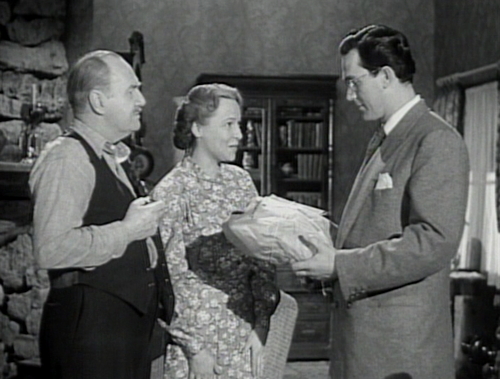
Mom completes the routine by handing Clark a parcel. “Here’s a uniform I made for you,” she says, “out of the blankets you were wrapped in, when we found you. It’s a strange kind of cloth, that resists both fire and acid.” If that’s the case, then I don’t know how she managed to cut it, and sew it together. Has anyone ever gotten to the bottom of that?

In the next scene, Clark’s leaving the house, and the announcer says, “Shortly after this, Clark’s foster parents passed away. Remembering their last wishes…”
And the audience says, what? They looked fine, just a second ago! What the hell happened in that house?
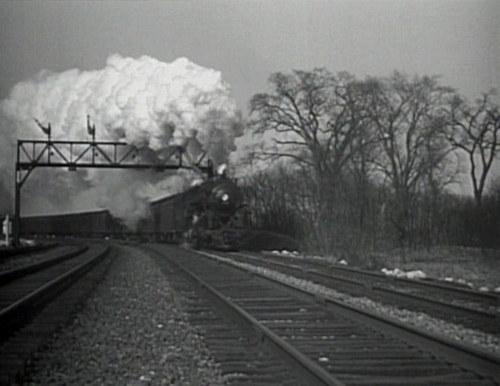
And then, inevitably, like summer following spring: a train. I don’t know why a young Clark Kent is attracted to trains like cats to catnip; it’s just one of those things.
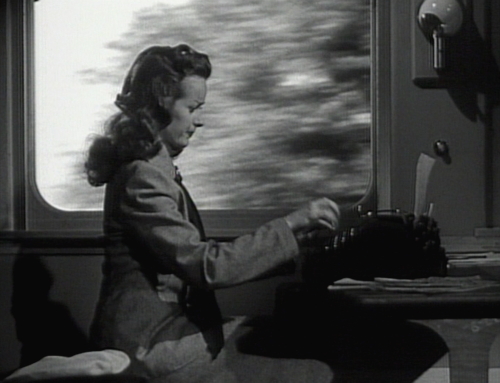
But look what’s inside, furiously tapping on her typewriter: Noel Neill as Miss Lois Lane, composing. She’s got no time to wait until Clark gets to Metropolis. It’s been thirty-eight years, and there’s only a couple minutes left in the installment; if he’s not going to come to her, then she’ll have to go and pick him up herself.
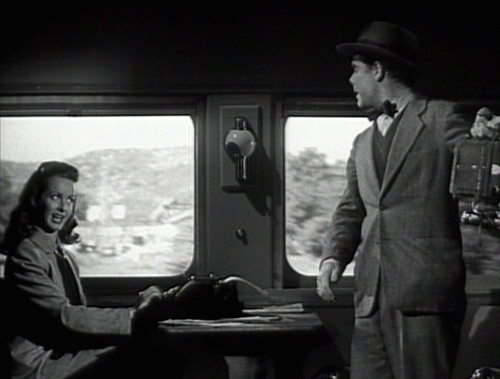
Neill’s Lois is instantly the most interesting person in the room — scolding, teasing and bossing Jimmy Olsen around, then smiling indulgently when he looks away. She’d spent a few years being the best thing in the “Teen Agers” musical comedy series as a bossy high school newspaper reporter, and she knows how to get the job done.
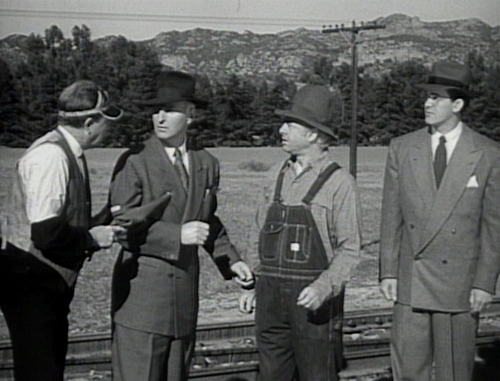
Clark shows up at the train platform, and naturally there’s an emergency: Lois and Jimmy’s train is approaching, and part of the track is busted; the train will crash if it speeds past this point. This is a problem that can only be solved by having everybody stand in a line and have a group discussion. There doesn’t seem to be any way to signal the train and get it to stop before it reaches the danger spot, which seems like a design flaw in the rail system that somebody should have been paying attention to, like, a while ago.

Disaster looming, Clark hops behind a bush and emerges in the brilliant costume of the high-flying hero Superman.
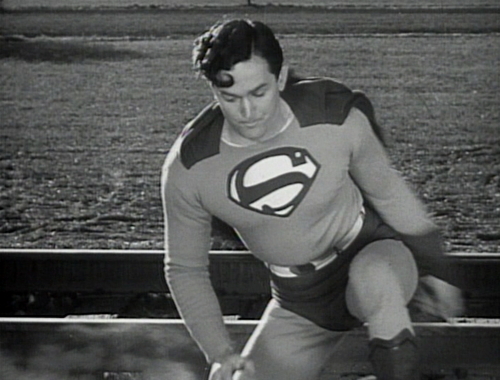
With only seconds to spare, Superman leaps over to the broken track, bends it back into shape, and basically just holds it there while the speeding train passes over his fingers.

That’s the end of the first chapter, and at the start of the second episode, he gets a little moment to stand up and be triumphant, and then it’s back behind the bush to change into Clark again.
This is an important aspect of the premise that so far has only been explored on the movie screen, here and in the Fleischer cartoons: that Superman needs to go and hide somewhere when he wants to swap identities. In the comics, it can happen between panels, and on the radio show, he just changes his voice — but in the serial, they have to show Kirk Alyn running behind a bush, which is not exactly dignified.

So that’s the kind of fun these two had with a train back in the day, and now they’ve got a cameo in Superman: The Movie. Unfortunately, in the theatrical version of the film, all you get to see is a brief shot of Noel giving the girl a puzzled frown, and the side of Kirk’s head.
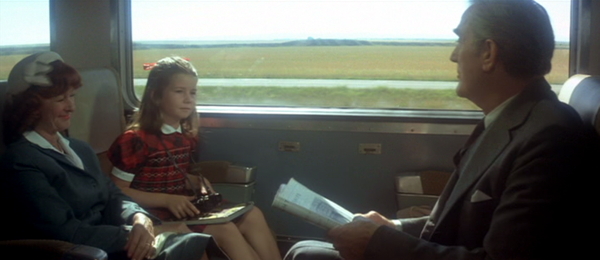
In the longer cuts of the movie — the 2000 Director’s Cut/Expanded Edition, and the three-hour TV Extended Cut — you get the full cameo scene, which is very cute, and one of the few extra moments that I think is worthwhile.
In this sequence, we see the family from inside the train, and the girl wakes her mother and points out the window.
“Golly!” she cries. “I saw a boy out there run as fast as a train! Faster, even!”
Her mother chuckles, and tweaks the girl’s nose. “Ha ha, Lois Lane!” she smirks. “You have a writer’s gift for invention; I’ll say that for you.”
The girl splutters, “But… but…” and her dad looks up to say, “Lois, please read your book.”
“No one ever believes me,” the girl crabs, as Noel Neill just sits there grinning, simply thrilled to be part of the story again.
So, I mean, I get why this scene is unnecessary, and possibly even misleading. The audience arrives at this moment knowing that “Lois Lane” is important — which means that this incident matters, and should be kept in mind when Lois returns to the screen around twenty minutes later. As the movie goes along, they might even wonder when Lois is going to recognize Superman as the boy in Kansas who ran past her train.
But the incident doesn’t matter, and it’s not referred to again. It’s a gun on the wall that doesn’t get fired, which means it’s a distraction, and it’s the kind of self-indulgent meta-joke that Richard Donner’s “verisimilitude” approach is specifically trying to avoid.
Still, it’s cute as hell, seeing the two of them on a train together, as the new Clark Kent speeds over the horizon, Metropolis-bound.
Tomorrow:
Is Jonathan Kent’s death
really necessary?
1.22: The Death of Uncle Ben
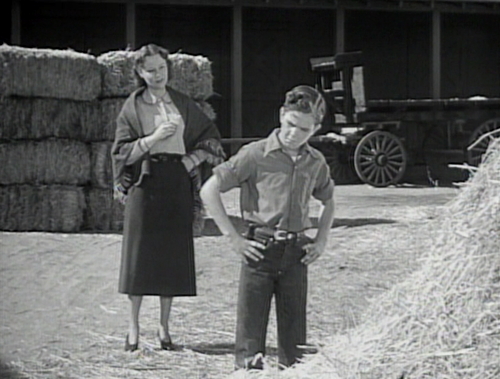
— Danny Horn

I do wish Clark had worn a mask or something when he ran past the train so that they could keep the whole scene. Reruns of The Adventures of Superman were a staple of daytime TV in the late seventies, so virtually all of the audience would have recognized Noel Neill and enjoyed the joke.
I love those kinds of Easter eggs in general- for example, I was very much disappointed Adam West didn’t make a cameo in the 1989 Batman, and was happy that Lynda Carter slipped into Wonder Woman 1984. The whole passing of the torch thing, you know.
LikeLiked by 4 people
I think Lois might connect the boy she saw with Superman but not necessarily with Clark Kent, who presents very differently.
LikeLiked by 2 people
The Superman serials are a lot of fun, and I’m glad you got to include them here. Both SUPERMAN (1948) and its sequel ATOM MAN VS SUPERMAN (1950) were on the DC Universe streaming service before it was canned in favor of HBO Max. Not all of DC’s content has made its way to HBO yet, but the trend they appear to be following is that they’re not porting everything over until they have HD copies (see: Superman the Animated Series and Lois & Clark: The New Adventures of Superman, for example). They did a great job transferring the Shazam serials to HD, so I have high hopes for high-definition Kirk Alyn Superman someday.
Of course, the second serial featured Lex Luthor on screen for the first time, so that’s a fun notable thing that maybe you’ll get to once you’re up to Gene Hackman’s appearance. He’s played in 1950 by none other than Ozzie and Harriet’s neighbor Joe Randolph, aka Lyle Talbot.
I don’t disagree with your assessment of Noel Neill’s Lois Lane in this context, but I’ve never been a big fan. After she played Lois in the serials, she was brought back as the character on the George Reeves TV series, replacing Phyllis Coates from the first season. To me, Coates is the perfect Lois Lane: smart, driven, and not too concerned with things that distract her from her job. Neil always played Lois as cutesy and more subservient to her co-workers; which is no doubt what the producers wanted.
Still, it was Neill’s version who became most beloved as they brought her back a lot over the years: Superman 78, Superman Returns, American Express commercials with Seinfeld, etc, and she was quite popular on the convention circuit. Coates was only brought back once to play Teri Hatcher’s Lois Lane’s mom in the 90s; and only for one episode, after which she was recast.
LikeLiked by 7 people
I preferred Phyllis Coates to Noel Neill too. The latter behaved stupidly and was always trying to expose Superman’s identity, which I found tedious. I always wondered how Noel felt about playing Lois as an imbecile.
LikeLiked by 3 people
She’s on record in more than one interview as (jokingly) being committed to the gag because she liked having a paid gig. By all accounts she really was an endearing lady.
LikeLiked by 3 people
I’m glad you brought it up — I took out the sentence “she’s one of the good ones” from the post. It’s really too early for me to make that call, based on the first couple chapters. (I’ve seen them all, but a while ago, and not with my film crit historian hat on.) Thank you for keeping me honest.
LikeLike
Scarecroe’s quote below says a lot: she was an actor from the Teen Agers films–which are hilariously bad, check them out on Rifftrax–trying to get a “grown up” role that paid, and it certainly wasn’t the only one out there where the so-called smart woman had to act like a moron about the hero because if she really used her brain the story would be over.
LikeLiked by 2 people
Lyle Talbot was also Commissioner Gordon in the 1949 Batman serial. Certainly the only person ever to play Lex Luthor and Jim Gordon!
LikeLike
> Certainly the only person ever to play Lex Luthor and Jim Gordon!
Corey Burton came close. He played Commissioner Gordon in an episode of Young Justice. He also voiced Brainiac on Superman: The Animated Series and on into Justice League for an episode where Brianiac and Lex Luthor merge into one being. I believe for this hybrid character, they combined Burton’s voice with regular Lex Luthor actor Clancy Brown.
LikeLiked by 1 person
> Certainly the only person ever to play Lex Luthor and Jim Gordon!
I found another one: Fred Tatasciore voiced Jim Gordon in DC Super Hero Girls and Lex Luthor in JLA Adventures: Trapped in Time.
LikeLiked by 1 person
Ah, nice! It’s not at all surprising that those two talented gentlemen did it.
LikeLiked by 1 person
Wow! I never realized that was Kirk Alyn in the train! I saw him at a small comic con in the late 1980’s and watched some of the serials. I recall we found it amusing that they replaced Kirk with a cartoon whenever Superman flew.
If memory serves, Ma Kent used a sharp edge on his rocket to cut the blanket, unravel it, and then reknit it as his uniform. There might have been an alternative version in which she tricked Superbaby into using his heat vision to cut the threads, too.
LikeLiked by 4 people
>>There might have been an alternative version in which she tricked Superbaby into using his heat vision to cut the threads, too.
I remember seeing that in a long-ago comic book, too.
LikeLiked by 2 people
I remember one Silver Age comic where Ma Kent was able to unstitch the fabric, and any cutting was done by taking advantage of any time little Clark used his heat vision (like making mud pies). At the time, the plan was not to make a superhero costume, but clothes that Clark won’t wear out. Later they added on: the yellow belt was the rocket’s safety harness, and the glass was used for his glasses.
I first learned about the Serial from the 1988 TV Special SUPERMAN 50TH ANNIVERSARY and Donald Glut’s THE GREAT MOVIE SERIALS. Several vhs of trailer compilations would have the serial trailer. The first time I saw an episode was in 1991 when Nick at Nite celebrated its addition of the 50s tv series by showing different adaptations of Supes, like the serials and the Fleischer animation. I finally got to see the whole serial on American Movie Classics in Spring 1993.
LikeLiked by 1 person
The MAD parody, “Superduperman,” had an okay joke about this sequence. The Pa Kent analogue points out that Clark is outrunning the Long Island Expressway train, an easy feat. (I guess it would shut down a lot in the ’70s.)
LikeLiked by 1 person
Noel Neill was a sweetheart of a person. Before I had even seen a rerun of “The Adventures of Superman,” it was more of a late 70’s daytime rerun thing, Noell Neil came to my high school’s Film Club Festival – she spoke, signed autographs, showed a film an of “Adventures of Superman” episode (I was surprised to see it was in color).
I agree that Phyllis Coates certainly was the more spunky of the two – but Noel did a scene where she cried real tears. I think Noel brought some real heart to the role.
Danny, my library copy of “Superman: The Movie” is unfortunately scratched in places. One of the few extra disks intact is the one which shows a “vintage TV special” called “The Making of Superman: The Movie,” which is more like an extended preview and features that male voice announcer from ABC, whose voice was prominent on ABC in the late 70’s. Anyhow, they interviewed Kirk Alyn and Noel Neill, in costume and apparently while they were filming the train scene! Kirk talks about some of the differences in approaching Superman in radio versus a visual medium – fun stuff.
LikeLiked by 1 person
I’d say Clark took Pa and Ma to a farm where they’d be happier, but they were already there! Hope it was painless.
And aww, Noel Neil! She still had her long hair here, too. She had fabulous locks in the Teenagers films–I found it funny that she was the tallest and most glamorous of the actresses playing the sisters so they stuck glasses on her and made her nerdy.
LikeLike
I was guilty of overthinking the Lois Lane “extra” scene since I first saw it. It bothered me that Lois is apparently at least 5 years younger than Clark. It makes more sense that they’re the same age roughly, considering she’s already an established reporter (with a penthouse apartment!) when they eventually meet.
LikeLiked by 1 person
Agreed, since it means Lois is also 5 – 8 years younger than Lana. In the comics Clark, Lois, and Lana were aways portrayed as being about the same age. It would’ve made more sense if the kid on the train had been Jimmy Olsen.
LikeLiked by 5 people